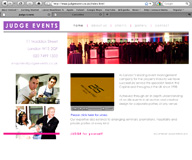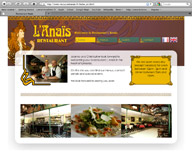write a post, tweet it
Autposting to twitter hopefully still working.
I think they changed something and Ive updated my social networks autoposting plugin.
I can tweet without having to!!

Don’t build your own website
As explained by the theory of comparative advantage.
This economic theory basically explains why your time is more cost effectively spent doing some activities rather than others – chiefly the ones that you are better at and hopefully those which are your core business or are going to directly enhance it and get you more paying customers.
There’s nothing here so far that is specific to web design but it’s relevant because web design does seem to be one of those areas where many people think that with a bit of reading, the right software package, possibly a build it yourself template and x number of free hours to learn how to do it, they could eventually produce something passable themselves and not have to pay our fees. And do you know what? They are right. It can be and is frequently done like this.
What I’m going to show here though is that the misnomer of saving money is a false economy based on a lack of understanding of the way that economics and business works.
That’s not to say that it’s always wrong in all circumstances to want to learn how to build and maintain your own website, but just be clear about the reasons behind it and what the true costs and “savings” are.
So let’s say you come to us and tell us about the website you want. We spec it out and quote you a price of £2000+VAT.
You feel that this price is very fair / perfectly reasonable but whichever way you look at it, it’s still £2000. Or even £2400 if you aren’t VAT registered. To a company that’s no big deal, but if you are a sole trader / one man band or at the very beginning stages of trading that’s still a wad of cash and if you aren’t yet bringing in much business then an outgoing of that size is fairly noticeable.
So instead you decide to learn how to build the site yourself. “How hard can it be?” is a question that many people in this situation might ask themselves.
Well I’ll tell you! Like many things in life if you want to do something basic that will tick the boxes you’ve asked it to it’s not that difficult. If you want something bespoke, unique or that looks like it was designed and built by a professional then you are going to need to use a professional.
Whilst you’ve spent the last 12 years in business, training or learning, we’ve been doing the same in the website industry.
So the first point is that if you think in a month or 2 you will be able to produce something of the equivalent standard that you would get if you paid a professional then you will be in for a surprise.
The second point, and this is where we get to the economics, is when we calculate the true cost of your “free” website.
How long would it take you to build an equivalent website to the one we quoted £2000 for?
A month (possibly but optimistic) 2, 3? Let’s say 200 hours just to put a figure on it? That’s probably being generous anyway but we need to start somewhere.
How much do you value your time at? Well how much do you charge it out for? What could you have earned in those 200 hours? £50 per hour, £40, £30.
Being really conservative let’s say 200 hours at £30 an hour. Well that’s £6000 whichever way you look at it. 300 hours and £50 an hour so a cost to you of £15,000 is equally possible.
So we’re saying that you spent somewhere between £6000 – £15,000 to save yourself £2000 and end up with a website that isn’t as good.
There are 2 main counter arguments that you might present to justify why building the site yourself isn’t really as bad an idea as I’ve just shown.
The first is that you would quite enjoy it and therefore wouldn’t necessarily see it as work / a chore. That might well be true but if that is the case then you should probably ask yourself how committed you really are to your business and its long term growth.
If you’d rather be doing our job than your own (whether in working hours or free time) then have you chosen the right business venture in the first place?
The second main objection is one more likely to be used by somebody who is fairly new in business / just started their company and that is that they didn’t have that much work on anyway.
By their logic my maths didn’t quite add up. They wouldn’t have earned £6000 in those 200 hours yet anyway. Maybe they wouldn’t have earned anything at all as the business is so new and there aren’t yet any paying jobs on the books.
This may be true but whatever you could have done in those 200 hours would have advanced your business more than learning how to build your own website – unless you are planning to open a web design agency that is 😉
As anyone who has started their own business will tell you, at the beginning in particular, it’s a long, slow, hard slog that involves putting in the hours and exploring every potential avenue of generating new business and getting yourself out there.
It’s not for us to know or say what are the best options for your business but whether it’s networking, cold calling, door to door selling, doing free work to build up your portfolio, writing a blog, tweeting or simply training or learning how to do your job even better, these will all advance your business and customer base more in 200 hours and one would hope earn a lot more than the £2k you saved.
So in summation:
Don’t waste time learning how to build your own website. Pay us (other reputable web designers are available) to build it and spend the time more wisely on endeavours that will benefit your own business directly.

Being an expert
Unless you happen to be in the unlikely situation of being the only company in the world that does what you do then the chances are you have competitors!
So how do you differentiate yourself?
Generally we compete either on price or quality. There are benefits to both.
For the industry we are in and for most of our clients there will always be someone cheaper who has better economies of scale or just is happy to produce inferior goods or services.
So the more logical conclusion and that of a company which takes pride in its work is to be better than the competition.
You don’t need to be the cheapest but if your work is excellent then clients come to you and recommend you on because they value quality and want to continue the same values to their client base.
Having taken the decision that this will be your business strategy then everything you produce, do or say should be about establishing yourself as expert in your industry and a bastion of quality that will be reflected in the work you do.
Your website (there was a point to all of this) is an excellent opportunity for you to establish yourself as an expert to your client (and perhaps even more importantly potential client) base.
Think about (or talk to your web designers about) how you can best use your website and general online marketing strategy to show the world how much you know about your industry, how much you understand about your clients and their requirements and how much you care about getting it just right.
It may seem counter intuitive but don’t be afraid to broadcast useful free information. Don’t just sell. Nobody likes to be sold to (at). What we like is to be offered useful interesting free learning that we can take away and apply to our businesses.
The fact that via your website, blog, tweets, Facebook page, enewsletter etc you give out useful tips and facts that will enhance the businesses of your clients but also complete strangers who may never even contact you, let alone become paying customers, doesn’t matter.
You will gain from it. Your existing customers and potential new ones will see over time that you are a valuable fountain of knowledge within your sector and even if they don’t need your services now, that day will come.
And when it does, and in our case they are looking to commission a website to support a new business endeavour, do you think they will go onto google and search for “cheap web designers London” or adopt the more shrewd strategy of contacting the company who they have been following for the last year anyway, reading their blog and absorbing the quality free information they have been broadcasting?
Your website is an excellent opportunity for you to establish yourself as an expert in your industry and your company as a provider of quality.
This will generate enquiries from motivated buyers who feel they already know you and are looking for a reliable supplier and a no risk project.

What’s a Gravatar?
Well this is what they say on www.gravatar.com:
A Globally Recognized Avatar
Your Gravatar is an image that follows you from site to site appearing beside your name when you do things like comment or post on a blog. Avatars help identify your posts on blogs and web forums, so why not on any site?
You may have noticed on blog sites forums etc that many users have a small image (usually of themselves but not necessarily) next to any posts or comments they make whereas many other users just have a default grey image or similar.
Well the users with an image haven’t done anything different on that particular site. They have once set up an account on the Gravatar site and that’s it.
Your image is related to your email address so anywhere you go on the Internet and post, comment, write etc and submit your email address as part of the process, your image will automatically get included.
When writing on forums or engaging with other members of a particular community, it’s all about relationship building (just like real life) so any extra that makes you more real, tangible or easier to relate to is only going to work in your favour.
And because it’s online and you can choose the image there is some scope for artistic licence.
If you aren’t that photogenic or are a bit older, greyer or more rotund than you would like to be (as opposed to being too young, thin or beautiful…) then that image taken by a professional photographer at your sister’s wedding or a web generated caricature (more about them in another post) could be just the ticket.
In summation, if you want to be heard, then you should be prepared to be seen. People are more likely to remember you from your image than from your username.

Online marketing funnel process
Online marketing is a funnel process.
Actually I guess this applies to most marketing but given that online marketing is what we know about then that’s what I’m talking about.
Imagine if you can a funnel – here’s an image of one in case you can’t!
The bottom of the funnel – the tip, that’s where someone buys something from you. A big something. Your core product and the one where you make your money.
Higher up the neck of the funnel are lower priced products that get the client used to buying from you and gradually building up their confidence in you. In our case that might be something like hosting or an email newsletter.
The bit where the neck meets the bowl (the collar?) – that’s the fulcrum point. It’s where they stopped being a prospect and became a customer.
Higher up in the bowl, that’s where the client has been aware of you, perhaps engaging with you in some way but no money changed hands. As they descend the bowl the interactions get more significant.
So at the very top would be something like Twitter. People follow you, read your tweets (maybe sometimes) and think you are interesting or relevant enough to be worth not stopping following.
Facebook and the various other social networking sites would be a little lower down the bowl. There’s more involvement in following you here both in terms of the quantity of content and the strength of your relationship. In the case of Twitter you may not know or know anything about the people following you more than their profile and what they are saying themselves if you have chosen to follow them back. On Facebook there’s a fair chance that you know (or have at least met once) the people who are your “friends” and likewise with Linked In.
Nearing the bottom of the bowl are email newsletters and blogs. They are similar but different and tend to have similarish content in them. People have different takes on these although general consensus does seem to be that a lot of email newsletters are annoying – particularly the ones you didn’t sign up for (well unsubscribe – but that’s another blog post).
Newsletters come to you and you probably dismiss most of them immediately – so like big tweets!
Blogs you tend to go looking for and if you value them you will go back. For me the blog is the point closest to the bottom of the bowl where a prospect is interested in you, in what you say and do and whether now or in the future is easiest to convert into becoming a customer when they have a requirement for your services.
If someone has a requirement for what you do (you can’t force that it just happens when it happens) then if they have spent the last x amount of time reading your tweets, posts, newsletters and blogs then the relationship has already been growing even if you weren’t fully aware of it.
When they are then ready to enter the neck of the funnel and put their money on the table, 3/4 of the selling process has already been done.








